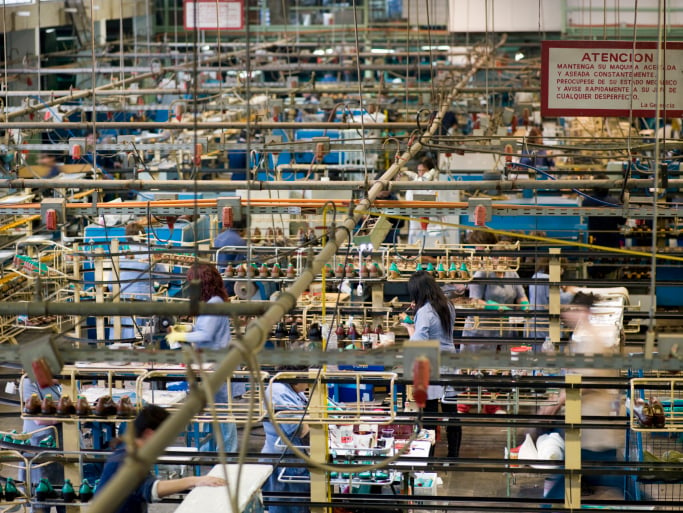Because of a major decline in jobs during the recession, the number of nonfarm workers is up just 5% over the past 10 years. While the past decade’s painful recession and the slow job growth that has followed have negatively affected most Americans, certain occupations have experienced job losses that were especially severe. Source: Thinkstock
Source: Thinkstock
24/7 Wall St. compared employment figures published by the Bureau of Labor Statistics (BLS) for hundreds of occupations from May of 2002 and May 2012. In that time, the estimated number of advertising and promotions managers fell by nearly two-thirds. Because of the housing crisis, many occupations in the construction sector were disproportionately hurt, while many manufacturing trades lost jobs due to structural changes in the economy. These are America’s disappearing jobs.
Click here to see what jobs are disappearing
According to Martin Kohli, Chief Regional Economist for the BLS, “most of these occupations were concentrated in industries that hemorrhaged jobs during the Great Recession and have not yet bounced back to their job levels of 2002.”
This is clearly the case in the construction industry where, according to a 2011 BLS study, 1.5 million jobs were lost from December 2007 to June 2009. This nearly 20% drop in construction-related jobs was the largest of any other major sector. Three of the five occupations with the largest decline in employment are in the construction sector, where job totals are still well below pre-recession levels.
The number of workers in other occupations has been greatly reduced because of technological improvements. Jobs in several manufacturing occupations have been made expendable because of advances in automation. For drilling and boring machine operators working with metals and plastics, as well as for textile workers, automation has helped contribute to a more than 50% decrease in jobs between 2002 and 2012. Work in several fields, including prepress technicians and computer operators, has also been cut by improved software and automation of processes that specialists once had to do by hand.
Several occupations on this list also have suffered from companies moving jobs abroad. U.S.-based semiconductor processors jobs fell by half between May 2002 and May 2012, partly because of the lower labor cost in other countries. Similarly, more than half of textile jobs were cut due to the combination of outsourcing and improved automation.
To determine the jobs with the highest percentage decline in employment, 24/7 Wall St. compared data from the BLS’s Occupational Employment Statistics program for both 2002 and 2012. We included only jobs with an estimated 20,000 employees or more. The figures are estimates subject to sampling error and do not count self-employed workers. Data are collected by the program over several years. We considered only occupations that existed in both 2002 and 2012, and excluded any occupations split-up or consolidated between these periods. The textile workers occupation is a combination of two similar occupations listed by the BLS. The bulleted data is for one of these categories, but we make reference to both in the description. Further information on each occupation came from the Occupational Outlook Handbook and O*Net OnLine.
10. Semiconductor Processors
> 10-year job pct. decline: -51%
> 10-year job decline: -22,250
> Total employed (2012): 21,380
> Median annual pay (2012): $33,020
Semiconductor processors have a poor job outlook despite the steady growth in the use of electronic devices. Technology has allowed semiconductors to become too small to be built efficiently by human hands, and production has become more automated and less manual as a result. The high standard for cleanliness in semiconductor work environments also makes robots more desirable. Already, the number of processors shrank by more than 51% from an estimated 43,630 in 2002 to only 21,280 in 2012. Another reason for the job losses is outsourcing. This trend should continue as companies look to lower operating expenses.
Also Read: The 10 Fastest-Growing Jobs in America
9. Prepress Technicians
> 10-year job pct. decline: -54%
> 10-year job decline: -47,950
> Total employed (2012): 41,420
> Median annual pay (2012): $37,260
Prepress technicians work primarily with print publications. But as more content is being consumed through online media, the printing industry has been shrinking and printing occupations have been on the decline. The bleak forecast, however, may be tempered by increased demand for print marketing and print logistics, which include labels, wrappers and packaging products, according to the BLS. Still, traditional prepress tasks can now be accomplished on word processors in advertising offices and public relations agencies and no longer need to take place at the printing press. The quantity of those employed has declined dramatically in the past decade, by more than 50%.
8. Word Processors and Typists
> 10-year job pct. decline: -54%
> 10-year job decline: -112,640
> Total employed (2012): 96,560
> Median annual pay (2012): $35,270
The number of word processors and typists declined by 54% between 2002 and 2012. While this wasn’t the largest percentage drop, it translated to more than 100,000 jobs lost — the highest amount among the 10 disappearing jobs. Word processors spend a lot of their time typing and transcribing letters and other documents. Advances in computers and new technology, as well as the growing popularity of electronic business transactions, may make the administrative and support tasks associated with word processors and typists virtually obsolete. Additionally, many office workers today are very familiar with word processing software.
7. Textile Knitting and Weaving Machine Setters, Operators and Tenders
> 10-year job pct. decline: -57%
> 10-year job decline: -28,300
> Total employed (2012): 21,110
> Median annual pay (2012): $26,540
Textile knitting and weaving machine workers are primarily employed to set up, monitor and operate machines used in the manufacturing of textile products. Decreases in textile worker employment have been largely the result of advancements in manufacturing technology, in addition to the growing tendency to outsource production activity to countries with cheaper labor, according to the BLS. However, while many Americans have blamed the low cost of labor abroad for the loss of such manufacturing jobs, a recent report from the McKinsey Global Institute noted that the majority of manufacturing jobs lost between 2000 and 2010 were due to increases in productivity.
6. Computer Operators
> 10-year job pct. decline: -59%
> 10-year job decline: -101,080
> Total employed (2012): 71,560
> Median annual pay (2012): $38,390
Computer operators refers in general to individuals who operate computer terminals and are responsible for monitoring data processing systems. Workers in this occupation must ensure the machines they work with are functioning properly, which involves checking and responding to error messages, as well as recording and documenting problems. However, the number of workers in these fields is declining because automation and improved computing reduce the need for dedicated operators, according to the BLS.
5. Brickmasons, Blockmasons, Stonemasons, Tile and Marble Setters — Helpers
> 10-year job pct. decline: -60%
> 10-year job decline: -36,430
> Total employed (2012): 24,310
> Median annual pay (2012): $28,220
Helpers for contractors work in the construction sector and are typically employed to assist in at least one or more phases of a construction project, ranging from laying the building foundation to applying the finishing touches. Typically, they work under masons and setters, but perform tasks that require less skill. These helpers are one of the occupations that have been extremely damaged by the housing crisis. According to two of the nation’s most widely followed home price indices, the S&P/Case-Shiller 20-City Composite and the Federal Housing Finance Authority’s House Price Index, home prices still remain well below pre-crisis levels.
Also Read: The Worst States to Be Unemployed
4. Drilling and Boring Machine Tool Setters, Operators, and Tenders, Metal and Plastic
> 10-year job pct. decline: -60%
> 10-year job decline: -31,070
> Total employed (2012): 20,660
> Median annual pay (2012): $33,940
According to the BLS, drilling and boring machine workers “set up, operate, or tend drilling machines to drill, bore, ream, mill, or countersink metal or plastic work pieces.” Such jobs often require knowledge of the properties of specific types of metals and plastics, so that materials are fed to the machine at the proper speed and cut to the necessary specifications. However, an increase in automation likely has contributed to declines in employment of these occupations. In the 10 years ending in May 2012, the number of workers handling such machines has fallen from an estimated total of more than 50,000 to just over 20,000.
3. Plasterers and Stucco Masons
> 10-year job pct. decline: -61%
> 10-year job decline: -33,250
> Total employed (2012): 21,040
> Median annual pay (2012): $37,130
Plasterers and stucco masons apply coating to walls and other surfaces for decorative and functional purposes. Because plasterers and stucco masons work in the construction sector, “workers in this trade can expect periods of unemployment when the overall level of construction falls,” according to the BLS. Unfortunately, home construction plunged during the housing crisis, and new housing starts — a measure of the volume of construction nationwide — remain well below historical levels. However, employment in these occupations may rise as construction activity recovers, the BLS notes.
2. Carpenters’ Helpers
> 10-year job pct. decline: -63%
> 10-year job decline: -62,030
> Total employed (2012): 35,870
> Median annual pay (2012): $25,550
Carpenters’ helpers assist in cutting timber and lumber, setting up scaffolding and smoothing surfaces, among other roles. They help carpenters by generally performing lower-skilled tasks. There were close to 98,000 carpenters’ helpers in 2002, but by May 2012, that number had fallen to less than 36,000. In that time, the number of carpenters also fell considerably. The estimated number of carpenters in 2012 was 34% lower than the estimated number for 2002. Jobs for carpentry workers were decimated by the housing crisis, and they may recover if the housing market improves and home building returns to pre-recession levels.
Also Read: The Best Paying Jobs for High School Graduates
1. Advertising and Promotions Managers
> 10-year job pct. decline: -65%
> 10-year job decline: -52,670
> Total employed (2012): 28,420
> Median annual pay (2012): $88,590
No occupation has lost a higher proportion of its jobs than advertising and promotions managers. Such managers help determine the media in which to advertise, conduct market research and help plan advertising campaigns. Likely a major factor in the decline of such positions has been the decline of advertising in print media, such as newspapers, according to the BLS. Kohli added, “during the recession, advertising for cars and many durables plummeted, and this contributed to [job] losses” in both print publishing and advertising.
Sponsored: Want to Retire Early? Here’s a Great First Step
Want retirement to come a few years earlier than you’d planned? Or are you ready to retire now, but want an extra set of eyes on your finances?
Now you can speak with up to 3 financial experts in your area for FREE. By simply clicking here you can begin to match with financial professionals who can help you build your plan to retire early. And the best part? The first conversation with them is free.
Click here to match with up to 3 financial pros who would be excited to help you make financial decisions.
Thank you for reading! Have some feedback for us?
Contact the 24/7 Wall St. editorial team.



